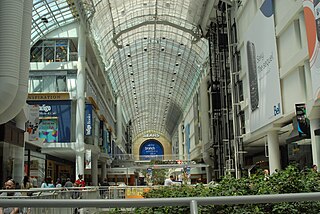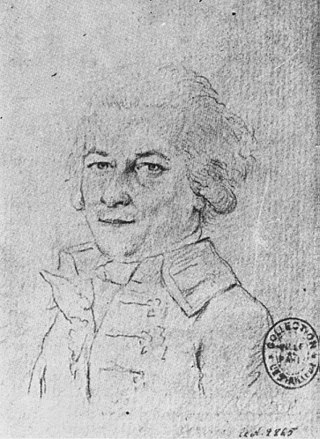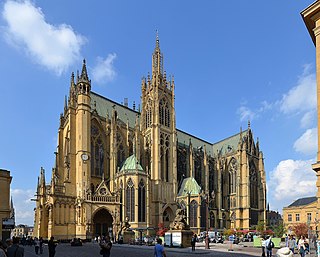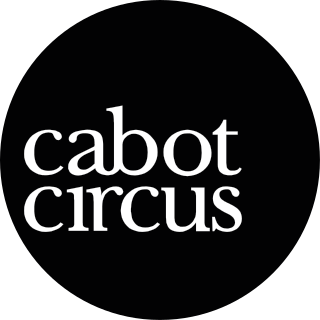
Metz is a city in northeast France located at the confluence of the Moselle and the Seille rivers. Metz is the prefecture of the Moselle department and the seat of the parliament of the Grand Est region. Located near the tripoint along the junction of France, Germany and Luxembourg, the city forms a central place of the European Greater Region and the SaarLorLux euroregion.

Vigevano is a comune (municipality) in the province of Pavia, in the Italian region of Lombardy. A historic art town, it is also renowned for shoemaking and is one of the main centres of Lomellina, a rice-growing agricultural district. Vigevano received the honorary title of city with a decree of Duke Francis II Sforza on 2 February 1532. It is famed for its Renaissance Piazza Ducale in the centre of the town. It is also known for the Rassegna Litteraria di Vigevano, an annual cultural event celebrating literature and the arts, which honours two distinguished personalities from the world of culture every year with the National Prize and the International Career Prize.

A shopping center in American English, shopping centre in Commonwealth English, shopping complex, shopping arcade, shopping plaza, or galleria, is a group of shops built together, sometimes under one roof.

Baroque architecture is a highly decorative and theatrical style which appeared in Italy in the late 16th century and gradually spread across Europe. It was originally introduced by the Catholic Church, particularly by the Jesuits, as a means to combat the Reformation and the Protestant church with a new architecture that inspired surprise and awe. It reached its peak in the High Baroque (1625–1675), when it was used in churches and palaces in Italy, Spain, Portugal, France, Bavaria and Austria. In the Late Baroque period (1675–1750), it reached as far as Russia, the Ottoman Empire and the Spanish and Portuguese colonies in Latin America. In about 1730, an even more elaborately decorative variant called Rococo appeared and flourished in Central Europe.

The Grand Bazaar in Istanbul is one of the largest and oldest covered markets in the world, with 61 covered streets and over 4,000 shops on a total area of 30,700 m2, attracting between 250,000 and 400,000 visitors daily. In 2014, it was listed No.1 among the world's most-visited tourist attractions with 91,250,000 annual visitors. The Grand Bazaar at Istanbul is often regarded as one of the first shopping malls of the world.

Yorkdale Shopping Centre, Yorkdale Mall, or simply Yorkdale, is a major retail shopping centre in Toronto, Ontario, Canada. Located at the southwest corner of the interchange between Highway 401 and Allen Road, it opened in 1964 as the largest enclosed shopping mall in the world. Yorkdale is currently the third largest shopping mall in Canada by floor space and has the highest sales per unit area of any mall in Canada, with current merchandise sales levels at roughly CA$1,905 per square foot. At 18 million annual visitors, it is one of the country's busiest malls. Many international retailers have ventured the Canadian market initially at Yorkdale.

Chadstone Shopping Centre is a shopping centre located in the south-eastern Melbourne suburb of Malvern East. Chadstone Shopping Centre is the biggest shopping centre in Australia by both area and number of stores and one of the biggest in the Southern Hemisphere. The centre opened on 3 October 1960 and was the first self-contained regional shopping centre in Melbourne.

Jacques-François Blondel was an 18th-century French architect and teacher. After running his own highly successful school of architecture for many years, he was appointed Professor of Architecture at the Académie Royale d'Architecture in 1762, and his Cours d'architecture largely superseded a similarly titled book published in 1675 by his famous namesake, François Blondel, who had occupied the same post in the late 17th century.

Robina Town Centre is a large shopping centre on the Gold Coast, Australia. The site covers 34 hectares in the suburb of Robina, with seven anchor tenants and over 400 retail outlets covering over 130,000 square metres (1,400,000 sq ft).

Metz Cathedral is the cathedral of the Catholic Diocese of Metz, the seat of the bishops of Metz. It is dedicated to Saint Stephen. The diocese dates back at least to the 4th century and the present cathedral building was begun in the early 14th century. In the mid-14th century, it was joined to the collegiate church of Notre-Dame, and given a new transept and late Gothic chevet, finished between 1486 and 1520. The cathedral treasury displays a rich collection assembled over the long centuries of the history of the Metz diocese and include sacred vestments and items used for the Eucharist.

Cathedral of Our Lady of the Assumption, also known as Matâ'Utu Cathedral, is a Roman Catholic cathedral, and a national monument of France, located in the town of Mata Utu on Uvea, in Wallis and Futuna. It is a dominant edifice in downtown Mata-Utu town, capital of Wallis Island. It bears the royal insignia of Wallis, a Maltese cross between its towers. The cathedral is also known as the "Our Lady of Good Hope Cathedral". It is the seat of Bishop Susitino Sionepoe.

Luxembourg railway station is the main railway station serving Luxembourg City, in southern Luxembourg. It is operated by Chemins de Fer Luxembourgeois, the state-owned railway company. 80,000 passengers use this station every day.
The Glen Shopping Centre is a major regional shopping centre located in Glen Waverley, Victoria, Australia. The head offices of MYOB are located in the centre.
Mace is a convenience shop symbol group operating as three separate entities with different ownerships in Great Britain, the Republic of Ireland and Northern Ireland. The shops are independently owned and join the groups, paying a fee for marketing and branding support and purchasing their stock from the brand owners.

Cabot Circus is a covered shopping centre in Bristol, England. It is adjacent to Broadmead, a shopping district in Bristol City Centre. The Cabot Circus development area contains shops, offices, a hotel, 250 apartments and formerly, a cinema. It covers a total of 139,350 m2 (1,500,000 sq ft) floor space, of which 92,900 m2 (1,000,000 sq ft) is retail outlets and leisure facilities. It opened in September 2008, after a ten-year planning and building project costing £500 million.

Odo of Metz or Eudes of Metz(fl. c. 806 – c. 811) was a Frankish architect, considered of Armenian origin, who lived in the Carolingian Empire during Charlemagne's reign.

The Centre Pompidou-Metz is a museum of modern and contemporary art located in Metz, capital of Lorraine, France. It is a branch of Pompidou arts centre of Paris, and features semi-permanent and temporary exhibitions from the large collection of the French National Museum of Modern Art, the largest European collection of 20th and 21st century arts. The museum is the largest temporary exhibition space outside Paris in France with 5,000 m2 (54,000 sq ft) divided between 3 galleries, a theatre, and an auditorium.

The Place Saint-Jacques is situated in the centre of Metz, France, in front of the centre Saint-Jacques, a three-storey mall. It is located between the Rue Fabert and the Rue Ladoucette, in the heart of the historic and pedestrian centre, near the cathedral.
Metz, the capital and the prefecture of the Moselle department in France, has a recorded history dating back over 2,000 years. During this time, it was successively a Celtic oppidum, an important Gallo-Roman city, the Merovingian capital of the Austrasia kingdom, the birthplace of the Carolingian dynasty, a cradle of Gregorian chant, and one of the oldest republics of the common era in Europe. As an important city in the heart of Europe and the crossroads of different cultures, Metz has variously experienced an integration into the Roman Empire, the period of christianization, the barbarian depredations, religious wars, the French Revolution, the Industrial Revolution, an annexation into the German Empire, and World War II.

The Imperial Quarter of Metz is a district of the city of Metz, in the région of Grand-Est, in eastern France, initially built between 1902 and 1914 by the government of the ruling German Wilhelmine Empire, during the period of annexation of Alsace-Lorraine. Originally named "Neue Stadt", it is today divided between the administrative district of New Ville and Metz-Centre.





















